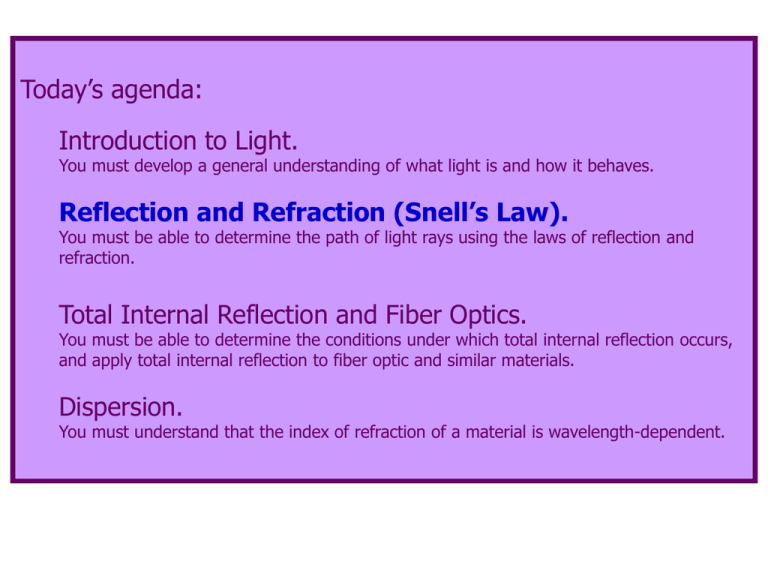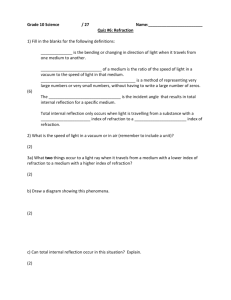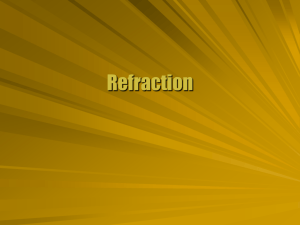PowerPoint
advertisement

Today’s agenda: Introduction to Light. You must develop a general understanding of what light is and how it behaves. Reflection and Refraction (Snell’s Law). You must be able to determine the path of light rays using the laws of reflection and refraction. Total Internal Reflection and Fiber Optics. You must be able to determine the conditions under which total internal reflection occurs, and apply total internal reflection to fiber optic and similar materials. Dispersion. You must understand that the index of refraction of a material is wavelength-dependent. Reflection Light striking a surface may be reflected, transmitted, or absorbed. Reflected light leaves the surface at the same angle it was incident on the surface: i = r i r Real Important Note: the angles are measured relative to the surface normal. Possible homework hint: the sum of the angles in a 4-sided polygon is 360. Reflection from a smooth surface is specular (mirrorlike). Reflection from a rough surface is diffuse (not mirror-like). http://acept.la.asu.edu/PiN/rdg/reflection/reflection.shtml http://www.mic-d.com/java/specular/ Refraction Light travels in a straight line except when it is reflected or when it moves from one medium to another. http://id.mind.net/~zona/mstm/physics/light/rayOptics/refraction/refraction1.html Refraction—the “bending,” or change of direction of light rays when light moves from one medium to a different one—takes place because light travels with different speeds in different media. The speed of light in a vacuum is c = 3x108 m/s. The index of refraction of a material is defined by c n = , v If you study light in advanced classes, you’ll find it is more complex than this. where c is the speed of light in a vacuum and v is the speed of light in the material. The speed and wavelength of light change when it passes from one medium to another, but not the frequency, so c v= and n = . n n Because light never travels faster than c, n 1.* For water, n = 1.33 and for glass, n 1.5. Indices of refraction for several materials are listed in your text. Example: calculate the speed of light in diamond (n = 2.42). c v = n 3×108 m/s v = 2.42 v = 1.24×108 m/s *Actually, not true but don’t worry about it unless you take advanced courses in optics. Because n 1, we see this: If n < 1, we would see this: Thanks to Dr. Xiaodong Yang for the images. Snell’s Law When light moves from one medium into another, some is reflected at the boundary, and some is transmitted. “Toy” The transmitted light is refracted (“bent”). a is the angle of incidence, and b is the angle of refraction. a b air (na) water (nb) water (na) b nb>na air (nb) a na>nb na sin θa = nb sin θb Light passing from air (n 1) into water (n 1.33). Light “bends” towards the normal to the surface as it slows down in water. a air (na) water (nb) b (1) sin θa = (1.33) sin θb θa > θb nb>na na sin θa = nb sin θb Light passing from water (n 1.33) into air (n 1). Light “bends” away from the normal to the surface as it speeds up in air. (1.33) sin θa = (1) sin θb b air (nb) water (na) θa < θb a na>nb na sin θa = nb sin θb Snell’s law, also called the law of refraction, gives the relationship between angles and indices of refraction: na sin θa = nb sin θb . air (na) air (na) a a b water (nb) b water (nb) You are free to choose which is “a” and which is “b.” is the angle the ray makes with the normal!




